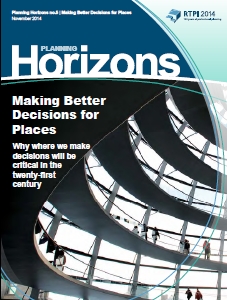Making Better Decisions for Places
In November 2014, the Royal Town Planning Institute published Making Better Decisions for Places: Why where we make decisions will be critical in the twenty-first century. This is one of five 'Planning Horizons' papers published during the RTPI's centenary year. The papers take a long term and global view of planning and the major challenges of the 21st Century.
The five Planning Horizons projects are:
- Thinking Spatially.
- Future Proofing Society.
- Promoting Healthy Cities.
- Creating Economically Successful Places.
- Making Better Decisions for Places.
Making Better Decisions for Places identifies a ‘contemporary crisis of government’ and argues that uncoordinated decision-making reduces the effectiveness of our response to major challenges. It suggests that, ‘Decision-makers at all levels need to be brought together to enable the best decisions for places, to ensure that communities are provided with the services and opportunities they need.’
The report presents examples of decisions made at inappropriate levels, and cites case studies where there are better governance arrangements, contrasting Leeds with the City of Malmö in Sweden.
It identifies four common failures:
- An inappropriate level of decision-making to deal with issues that cross administrative boundaries.
- Siloed policy and decision-making.
- Governing by borders rather than functional geographies.
- A lack of understanding of ‘subsidiarity’, and the importance of having well-resourced institutions.
The report sets out four ‘tests’ for successful devolution that might overcome these failures:
- Identifying those decisions that have a primarily national impact and those that have a primarily sub-national impact.
- Allowing policy decisions to be made according to where policies interact.
- Aligning governance arrangements with functional economic areas rather than administrative borders.
- Ensuring institutions are suitably equipped and resourced to make and implement decisions.
Cath Ranson, President of the RTPI, said, “Understanding what we want to create for local places requires a whole range of actors in the public, private and third sectors to work together – in particular communities need to be closely involved in decision-making. The challenges of making sustainable, better places won’t be resolved by one organisation alone, or indeed by one profession. Decision-makers at all levels need to be brought together to enable the best decisions for places, to ensure that communities are provided with the services and opportunities they need.”
[edit] Related articles on Designing Buildings Wiki
Featured articles and news
Government consultations for the summer of 2025
A year of Labour, past and present consultations on the environment, the built environment, training and tax.
CMA competitiveness probe of major housing developers
100 million affordable housing contributions committed with further consultation published.
Homes England supports Greencore Homes
42 new build affordable sustainable homes in Oxfordshire.
Zero carbon social housing: unlocking brownfield potential
Seven ZEDpod strategies for brownfield housing success.
CIOB report; a blueprint for SDGs and the built environment
Pairing the Sustainable Development Goals with projects.
Types, tests, standards and fires relating to external cladding
Brief descriptions with an extensive list of fires for review.
Latest Build UK Building Safety Regime explainer published
Key elements in one short, now updated document.
UKGBC launch the UK Climate Resilience Roadmap
First guidance of its kind on direct climate impacts for the built environment and how it can adapt.
CLC Health, Safety and Wellbeing Strategy 2025
Launched by the Minister for Industry to look at fatalities on site, improving mental health and other issues.
One of the most impressive Victorian architects. Book review.
Common Assessment Standard now with building safety
New CAS update now includes mandatory building safety questions.
RTPI leader to become new CIOB Chief Executive Officer
Dr Victoria Hills MRTPI, FICE to take over after Caroline Gumble’s departure.
Social and affordable housing, a long term plan for delivery
The “Delivering a Decade of Renewal for Social and Affordable Housing” strategy sets out future path.
A change to adoptive architecture
Effects of global weather warming on architectural detailing, material choice and human interaction.
The proposed publicly owned and backed subsidiary of Homes England, to facilitate new homes.
How big is the problem and what can we do to mitigate the effects?
Overheating guidance and tools for building designers
A number of cool guides to help with the heat.
The UK's Modern Industrial Strategy: A 10 year plan
Previous consultation criticism, current key elements and general support with some persisting reservations.
Building Safety Regulator reforms
New roles, new staff and a new fast track service pave the way for a single construction regulator.

























